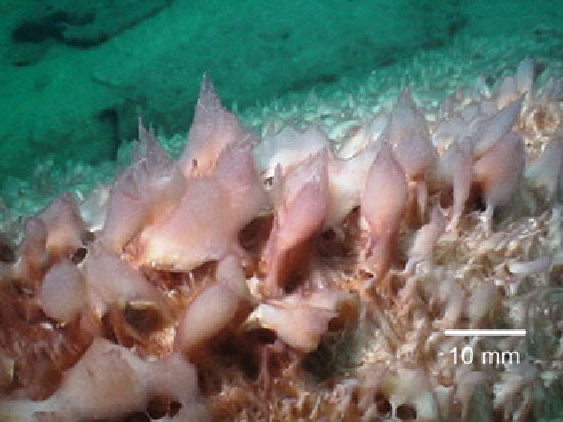Geoscience Reference
In-Depth Information
Fig. 8.35
Underwater photograph of a microbial mat at 8 m depth in Lake Hoare, McMurdo
Dry Valleys, Antarctica. It is not known why the microbes form this pinnacled surface, but it is
speculated it could be an adaptation to low light and stagnant water
(
http://aut.researchgateway.ac.
nz/bitstream/handle/10292/1449/1801.pdf?sequence=5
- NIWA/Image Copyright by: R. Ellwood,
2004)
Using underwater micro-sensors, they were able to prove that, during the Antarctic
summer, mats in Lake Hoare are capable of using extremely low ambient light to
fix carbon and to release oxygen into the already supersaturated lake water. With
their measurements, those scientists have generated new insights into the physiology
of photosynthesis under low-light and near-freezing conditions, and confirmed key
aspects of photosynthesis previously based only on laboratory measurements. These
findings greatly advance our understanding of the ecology of ice-covered polar
lakes, and help illuminate the mats' secret geological record” (Vopel and Hawes
2006
).
These findings are of great importance for the possibility of fossilized, dormant,
or (hypothetically) living microbial mats deep underground below Mars' icy
subsurface (Fig.
8.35
).
The second objective regarding Mars terraforming in this chapter is the following
proposal: I suggest it would be better to introduce greenhouse gases not directly into
Mars' atmosphere but into an isolated Martian atmosphere by means of a robotic
spacecraft putting those gases into a closed, simple 10-m-radius greenhouse with
simple chambers (which can be easily fixed by astronauts), firmly attached to the
ground. For an initial Mars terraforming, it is needed to liquefy water from the Mar-
tian subsurface ice (de Morais
2004
). This heating of the atmosphere could be eased
by the use of greenhouse gases - sulfur, fluor, and carbon molecules (Marinova
et al.
2000
). But since we know very few about present-day Mars, not talking about

Search WWH ::

Custom Search